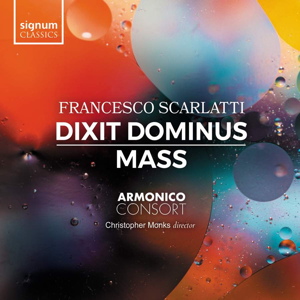
Francesco Scarlatti (1666-1741)
Dixit Dominus a 16 voci con instromenti, Tono 8
Messa a 16 voci con instromenti, Toni 2
Armonico Consort/Christopher Monks
rec. 2022, All Hallows Church, Gospel Oak, London, UK
Sung texts with English translation enclosed.
Reviewed as download from press preview.
Signum Classics SIGCD740 [54]
Two members of the Italian Scarlatti family have been immortalised in music history: opera pioneer Alessandro and his son Domenico, whose fame rests primarily on his 555 keyboard sonatas. But there were several other members who also had careers in music and Francesco, Alessandro’s younger brother, was one of them. He was leader of the court orchestra in Naples for some years but then returned to his hometown Palermo in Sicily, where he remained for 24 years. He moved to London in 1719, where his name appears in many concert programmes during the next few years, until in 1733 he moved to Dublin, where he was struck by illness and died impoverished in 1741.
Unfortunately, a lot of his music has been lost, and the survival of the two works on the present disc is actually a result of his moving to London. They were composed during his time in Palermo, in 1702 and 1703, but the autograph scores were found in a library in Oxford. It is unclear how they got there. Concerning the purpose of the compositions nothing is known, but according to Geoffrey Webber’s liner notes, it wasn’t necessarily for liturgical use “since public and private concert performances sometimes included settings of these words”. I am no specialist in baroque music, but it seems to me that at least the Dixit Dominus in Scarlatti’s version would qualify for a place in a profane concert. The text, from Psalm 110, is powerful and dramatic with lines like “The Lord … shall wound even kings in the day of his wrath. He shall judge the nations, fill the places with destruction, and shatter the skulls in the land of the many”. Though Francesco obviously didn’t compose any operas, he seemingly had the same sense for drama as his older brother, and the greater part of Dixit Dominus is full of dramatic gestures: lively, dance-like and jubilant. It is set for 16 voices, divided into 4 four-part quartets, in order to avoid parallel fifth and octaves movement, which was “illegal” in strict counterpoint. This means that the individual voices have to “jump about” to follow the rules. As a result there is perpetual movement, which creates a sense of dramatic intensity. Another feature is the way Scarlatti groups many ensemble movements together by voice part. Instead of the standard mix of solos and duets, we hear three or often four singers on the same voice part singing together. The effect is highly original and makes this music stand out from his contemporaries. Dixit Dominus is truly fascinating; vital, virtuoso and volatile. Added to this is the employment of a high trumpet part, superbly played by Peter Mankarious.
The same compositional principles are also at work in the Mass, but here the mood is more liturgical and traditionally sacred. The Kyrie is noble, the Gloria beautiful, Gratias agimas tibi light and airy, Domine Deus, Agnus Dei mild and comforting. In several places obbligato violin parts add to the mildness until the last four movements where the music grows towards a mighty conclusion. In every respect this is a touching mass.
The sixteen singers and seven instrumentalists of Armonico Consort impress greatly and readers interested in byways of the baroque repertoire should find much to admire in the wilful Francesco Scarlatti’s highly individual music.
Göran Forsling
Help us financially by purchasing from





















